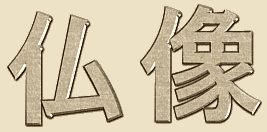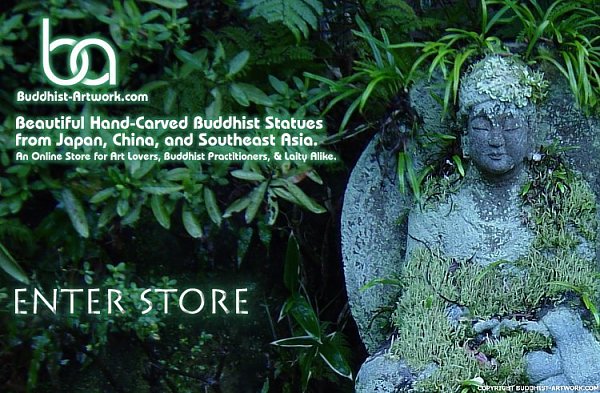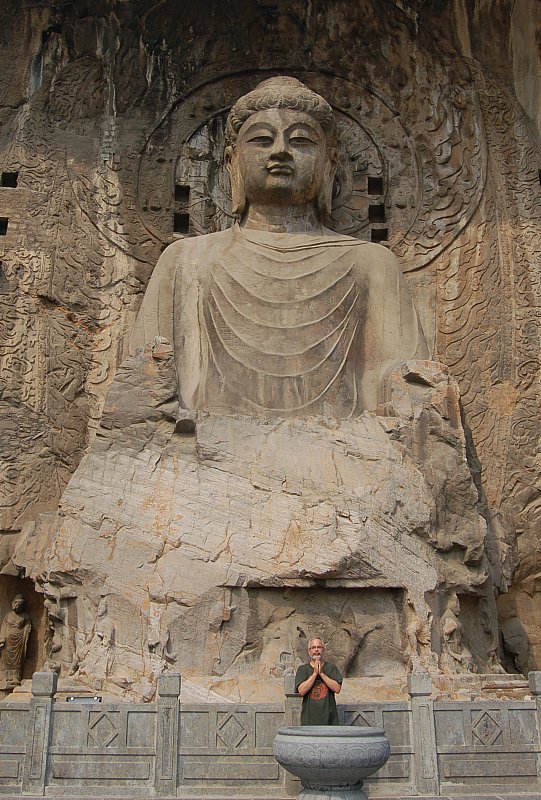|
BUDDHA STATUES


|
Buddha Statues for Online Purchase. The growing success of the A-to-Z Dictionary (this site) led to the launch of Buddhist-Artwork.com in July 2006. Buddhist-Artwork.com is an online store selling hand-carved wooden Buddha statues and Bodhisattva carvings, especially those crafted for the Japanese and Chinese markets. Buddhist-Artwork is our sister site, our commercial arm, while the A-to-Z Dictionary functions as a noncommercial knowledge center.
|
|
|
Comparing Modern Buddhist Statuary in Asia
Buddha Statues Differ Greatly Among Asian Nations.
Most web sites sell statues from Tibet, Nepal, and India.
Our estore, in contrast, is devoted to Japanese statuary.
|
|
Japan
|
Mahayana
& Esoteric
|
Statues: Wood primarily. Sublime, subtle, with great attention to realistic features & proportions. Very unique to Japan, and primarily from the Mahayana tradition. Japan’s Esoteric statuary, however, remains akin to earlier Hindu forms. Our sister site, Buddhist-Artwork.com, sells 100+ statues from the Japanese tradition. Almost all pieces are wood statues.
|
|
India
|
Hindu,
Therevada
& Esoteric
|
Statues: Metal & Stone primarily. Often multi-armed & multi-headed. Lack realism & life-like proportions. Very exaggerated features, akin to original Hindu forms.
|
|
Southeast Asia,
Sri Lanka, Burma
Cambodia, Laos, Thailand
|
Therevada Primarily
|
Statues: Metal, Stone, & Wood primarily. Often with elongated facial features, hands, and limbs. Lack life-like proportions. Distinctly different from Japanese styles, especially the facial features.
|
|
Tibet
Mongolia
|
Mahayana
& Esoteric
|
Statues: Metal & Stone primarily. Kannon statues predominate. Other deities often very esoteric, with multiple heads & arms. Esoteric Buddhism practiced mainly in Tibet, but has strong hold among Japan’s Shingon & Tendai sects.
|
|
Vietnam
|
Mahayana
|
Statues: Elongated faces, hands, & limbs.
|
|
Korea
|
Mahayana
|
Statues: Similar to Japan. Korea in fact introduced Buddhism to Japan.
|
|
China
|
Mahayana
Taoist
Confucianist
|
Statues: Metal, Stone, Ceramic, Wood. Tendency toward gaudiness & loud colors, yet Mahayana iconography very similar to Japan. China was biggest influence on Japanese Buddhism.
|
|
Learn Much More About the
Three Main Schools of Buddhism in Asia
|
|
A-to-Z Photo Dictionary of Japan’s Buddhist & Shinto Deities
This site (the site you are now viewing) is perhaps the world’s largest online visual database devoted to Japanese Buddhist statuary. Online since 1995, it is widely referenced by universities, museums, galleries, art historians, students, Buddhist practitioners, and lay people from around the world. The photo dictionary now contains 4,000+ photos of Buddhist artwork and, to a lesser degree, of Shinto art. It also contains hundreds of textual reviews of the many deities in Japan’s Buddhist and Shinto pantheon, including demons and monsters, judges of hell, noted monks and teachers, and religious icons and symbolism. Updated frequently. Click a link in the left column to get started.
About the Site Creator
Mark Schumacher is a longtime Japan resident. He has been photographing and cataloging and learning about Buddhist statuary for over 12 years. He holds a BA in Asian Studies (Hamline University), and an MA in Japanese Studies (Johns Hopkins University). He is trained in both the Japanese and Chinese languages. He works out of his home in Kamakura as a writer, editor, PC consultant, web designer, and translator (J-E) for major Japanese and foreign entities. Born in Minnesota (USA). Collecting Buddha statues has been a longtime passion for Mark, and he enjoys sharing this enthusiasm. Resume here.
- The A-to-Z Photo Dictionary and Buddhist-Artwork.com are not associated with any educational institution, private corporation, governmental agency, or religious group.

Vairocana Buddha (Jp. = Dainichi Nyorai) at Fengxian Temple 奉先寺, China
Ancestor Worshipping Temple. Statues is 17 meters in height; carved in limestone.
Site Author Mark Schumacher at bottom of photo.
Longmen Caves Photo Tour Here

Buy Quality Buddhist Statuary
Our Sister Store Offers 100+ Hand Carved Products
Click here to enter our Online Buddha Statue Store
|